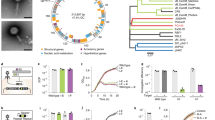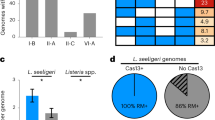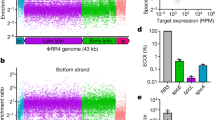Abstract
All viruses require strategies to inhibit or evade the immune pathways of cells that they infect. The viruses that infect bacteria, bacteriophages (phages), must avoid immune pathways that target nucleic acids, such as CRISPR–Cas and restriction-modification systems, to replicate efficiently1. Here we show that jumbo phage ΦKZ segregates its DNA from immunity nucleases of its host, Pseudomonas aeruginosa, by constructing a proteinaceous nucleus-like compartment. ΦKZ is resistant to many immunity mechanisms that target DNA in vivo, including two subtypes of CRISPR–Cas3, Cas9, Cas12a and the restriction enzymes HsdRMS and EcoRI. Cas proteins and restriction enzymes are unable to access the phage DNA throughout the infection, but engineering the relocalization of EcoRI inside the compartment enables targeting of the phage and protection of host cells. Moreover, ΦKZ is sensitive to Cas13a—a CRISPR–Cas enzyme that targets RNA—probably owing to phage mRNA localizing to the cytoplasm. Collectively, we propose that Pseudomonas jumbo phages evade a broad spectrum of DNA-targeting nucleases through the assembly of a protein barrier around their genome.
This is a preview of subscription content, access via your institution
Access options
Access Nature and 54 other Nature Portfolio journals
Get Nature+, our best-value online-access subscription
$29.99 / 30 days
cancel any time
Subscribe to this journal
Receive 51 print issues and online access
$199.00 per year
only $3.90 per issue
Buy this article
- Purchase on Springer Link
- Instant access to full article PDF
Prices may be subject to local taxes which are calculated during checkout




Similar content being viewed by others
Data availability
All data generated or analysed during this study are included in this published article and its Supplementary Information files.
References
Koonin, E. V., Makarova, K. S. & Wolf, Y. I. Evolutionary genomics of defense systems in archaea and bacteria. Annu. Rev. Microbiol. 71, 233–261 (2017).
Bondy-Denomy, J., Pawluk, A., Maxwell, K. L. & Davidson, A. R. Bacteriophage genes that inactivate the CRISPR/Cas bacterial immune system. Nature 493, 429–432 (2013).
Pawluk, A., Bondy-Denomy, J., Cheung, V. H. W., Maxwell, K. L. & Davidson, A. R. A new group of phage anti-CRISPR genes inhibits the type I-E CRISPR–Cas system of Pseudomonas aeruginosa. MBio 5, e00896-e14 (2014).
Pawluk, A. et al. Inactivation of CRISPR–Cas systems by anti-CRISPR proteins in diverse bacterial species. Nat. Microbiol. 1, 16085 (2016).
van Belkum, A. et al. Phylogenetic distribution of CRISPR–Cas systems in antibiotic-resistant Pseudomonas aeruginosa. MBio 6, e01796-e15 (2015).
Makarova, K. S. et al. An updated evolutionary classification of CRISPR–Cas systems. Nat. Rev. Microbiol. 13, 722–736 (2015).
Marino, N. D. et al. Discovery of widespread type I and type V CRISPR–Cas inhibitors. Science 362, 240–242 (2018).
Cady, K. C., Bondy-Denomy, J., Heussler, G. E., Davidson, A. R. & O’Toole, G. A. The CRISPR/Cas adaptive immune system of Pseudomonas aeruginosa mediates resistance to naturally occurring and engineered phages. 194, 5728–5738 (2012).
Pawluk, A. et al. Naturally occurring off-switches for CRISPR–Cas9. Cell 167, 1829–1838 (2016).
Rauch, B. J. et al. Inhibition of CRISPR–Cas9 with bacteriophage proteins. Cell 168, 150–158 (2017).
Chaikeeratisak, V. et al. Assembly of a nucleus-like structure during viral replication in bacteria. Science 355, 194–197 (2017).
Chaikeeratisak, V. et al. The phage nucleus and tubulin spindle are conserved among large Pseudomonas phages. Cell Rep. 20, 1563–1571 (2017).
Kraemer, J. A. et al. A phage tubulin assembles dynamic filaments by an atypical mechanism to center viral DNA within the host cell. Cell 149, 1488–1499 (2012).
Erb, M. L. et al. A bacteriophage tubulin harnesses dynamic instability to center DNA in infected cells. eLife 3, e03197 (2014).
Zehr, E. A. et al. The structure and assembly mechanism of a novel three-stranded tubulin filament that centers phage DNA. Structure 22, 539–548 (2014).
Bryson, A. L. et al. Covalent modification of bacteriophage T4 DNA inhibits CRISPR–Cas9. mBio 6, e00648-15 (2015).
Strotskaya, A. et al. The action of Escherichia coli CRISPR–Cas system on lytic bacteriophages with different lifestyles and development strategies. Nucleic Acids Res. 45, 1946–1957 (2017).
Vlot, M. et al. Bacteriophage DNA glucosylation impairs target DNA binding by type I and II but not by type V CRISPR–Cas effector complexes. Nucleic Acids Res. 46, 873–885 (2018).
Huang, L. H., Farnet, C. M., Ehrlich, K. C. & Ehrlich, M. Digestion of highly modified bacteriophage DNA by restriction endonucleases. Nucleic Acids Res. 10, 1579–1591 (1982).
Abudayyeh, O. O. et al. C2c2 is a single-component programmable RNA-guided RNA-targeting CRISPR effector. Science 353, aaf5573 (2016).
Gootenberg, J. S. et al. Nucleic acid detection with CRISPR-Cas13a/C2c2. Science 356, 438–442 (2017).
Meeske, A. J. & Marraffini, L. A. RNA guide complementarity prevents self-targeting in type VI CRISPR systems. Mol. Cell 71, 791–801 (2018).
Al-Shayeb, B. et al. Clades of huge phage from across Earth’s ecosystems. Preprint at bioRxiv https://www.biorxiv.org/content/10.1101/572362v1 (2019).
Chaikeeratisak, V. et al. Viral capsid trafficking along treadmilling tubulin filaments in bacteria. Cell 177, 1771–1780 (2019).
Choi, K.-H. & Schweizer, H. P. mini-Tn7 insertion in bacteria with single attTn7 sites: example Pseudomonas aeruginosa. Nat. Protoc. 1, 153–161 (2006).
Jinek, M. et al. A programmable dual-RNA-guided DNA endonuclease in adaptive bacterial immunity. Science 337, 816–821 (2012).
Cowles, K. N. et al. The putative Poc complex controls two distinct Pseudomonas aeruginosa polar motility mechanisms. Mol. Microbiol. 90, 923–938 (2013).
Acknowledgements
Research in the J.B.-D. laboratory was supported by the University of California San Francisco Program for Breakthrough in Biomedical Research, which is funded in part by the Sandler Foundation, and an NIH Office of the Director Early Independence Award (DP5-OD021344 (J.B.-D.) and R01-GM127489 (J.B.-D.)). This work was also supported by HHMI (D.A.A.) and NIH grants R35GM118099 (D.A.A.) and GM104556 (D.A.A., J.P.). ΦKZ, JBD30, JBD68, D3 and F8 were provided by the laboratory of A. Davidson and ΦPA3 by the D.A.A. laboratory; phage DMS3m was a gift from G. O’Toole; the S. pyogenes cas9 expression plasmid for integration in the PAO1 chromosome was from J. M. Peters and C. A. Gross; pTE4495 (MbCpf1/MbCas12a) (Addgene plasmid 80339) was a gift from E. Welker; LseCas13a (Addgene plasmid 83486) was a gift from J. Doudna; pSB1A3 EcoRI Methylase-AmilCP and pSB1A3 EcoRI-RTX with EcoRI Methylase-AmilCP (Addgene plasmids 85166 and 85165) were gifts from R. Dowell; and the type I-F crRNA expression plasmid pAB04 was from A. Borges (J.B.-D. laboratory).
Author information
Authors and Affiliations
Contributions
S.D.M. constructed strains and performed experiments relating to restriction modification, relocalization of enzymes, Cas13, Cas12 and all liquid infection assays, and prepared figures. E.S.N. performed fluorescence microscopy experiments with guidance from V.C. and J.P., and strain construction and data analysis under the supervision of D.A.A. S.G. performed microscopy experiments, strain construction, plaque assays, data analysis, in vitro digestion assays and Cas13 escaper experiments. L.M.L. performed type I-C Cas3 experiments. J.D.B. constructed and performed experiments with Cas9-expressing strains and performed in vitro digestion assays. A.T. isolated and sequenced Cas13 escaper phages. J.B.-D. conceived the project, performed Cas3 and Cas9 experiments, supervised all experiments and wrote the manuscript together with S.D.M. All authors edited the manuscript.
Corresponding author
Ethics declarations
Competing interests
J.B.-D. is a scientific advisory board member of SNIPR Biome and Excision Biotherapeutics and a scientific advisory board member and co-founder of Acrigen Biosciences.
Additional information
Publisher’s note Springer Nature remains neutral with regard to jurisdictional claims in published maps and institutional affiliations.
Peer review information Nature thanks Eugene Koonin and the other, anonymous, reviewer(s) for their contribution to the peer review of this work.
Extended data figures and tables
Extended Data Fig. 1 Jumbo phage ΦPA3 resists targeting by CRISPR–Cas systems and an R-M system.
a, Strain PAO1 was engineered to express the type I-C Cas genes and distinct crRNAs that target the indicated phages. b, Strain PAO1 was engineered to express the type II-A Cas9 protein and distinct sgRNAs that target the indicated phages. c, The endogenous type I R-M system (hsdRSM) in wild-type PAO1 and a mutant strain with an isogenic hsdR knockout (PAO1∆ hsdR) was assayed using phages that were propagated on PAO1 or PAK as indicated, and strains were subjected to a plaque assay. All plaque assays were conducted as in Fig. 1a and were replicated twice with similar results.
Extended Data Fig. 2 Phage ΦKZ resists P. aeruginosa type I-C and type I-F CRISPR–Cas immunity.
a, Strain PAO1 was engineered to express the type I-C Cas genes and distinct crRNAs that target phage JBD30 and phage ΦKZ. b, Strain PAO1 was engineered to express the type I-F Cas genes and distinct crRNAs that target phage JBD30 and phage ΦKZ. All plaque assays were conducted as in Fig. 1a and were replicated two or more times with similar results.
Extended Data Fig. 3 Phage ΦKZ resists targeting by heterologous type II-A and V-A CRISPR–Cas systems.
a, Strain PAO1 was engineered to express the type II-A Cas9 protein and distinct sgRNAs that target the indicated phages. b, Strain PAO1 was engineered to express the type V-A Cas12a protein and distinct crRNAs against the indicated phages. All plaque assays were conducted as in Fig. 1a and were replicated two or more times with similar results.
Extended Data Fig. 4 Quantification of Cas9 localization during phage ΦKZ infection of P. aeruginosa.
The localization of Cas9 and ORF152 in the cytoplasm and shell during ΦKZ infection was quantified. Data points (individual cells) from two pooled replicate experiments are fitted with a line and 95% confidence intervals are indicated with dashed lines. The slope is as reported in the plots.
Extended Data Fig. 5 Phage ΦKZ gDNA is susceptible in vitro to cleavage by restriction endonucleases.
gDNA was isolated from phages ΦKZ and JBD30 and subjected to digestion with the indicated restriction enzymes in vitro. The number of cut sites for each enzyme is shown at the bottom of the gels. Products were visualized on a 0.7% agarose gel stained with SYBR Safe. The experiment was replicated twice with similar result.
Extended Data Fig. 6 Cas9 protein fused to ORF152 localizes to the periphery of the shell, but does not enable immune activity against ΦKZ.
a, Strain PAO1 was engineered to express Cas9 fused to ORF152 at either the N or the C terminus, with sgRNAs targeting the indicated phages. b, Growth curves measuring the OD600 nm of PAO1 cells that were infected with ΦKZ at the indicated MOI. c, Fluorescence microscopy of PAO1 fusion strains, immunostained for Cas9, in cells that express ORF152–Cas9 or Cas9–ORF152. d, Fluorescence microscopy of P. aeruginosa, immunostained for Cas9, in cells that express ORF152–Cas9. The DAPI stain in c, d shows the phage DNA within the shell. All plaque assays were conducted as in Fig. 1a and were replicated four times with similar results. The growth curve experiments (b) were replicated three times with similar results. Microscopy (c, d) was replicated twice with similar results.
Extended Data Fig. 7 Fusion of EcoRI restriction enzymes to ORF152 enables immune activity.
a, Strain PAO1 was engineered to express EcoRI or an EcoRI–ORF152 fusion protein. Plaque assays were conducted as in Fig. 1a and quantified (n = 3). b, Growth curves measuring the OD600 nm of PAO1 cells that were infected with ΦKZ at the indicated MOI. c, d, Live-cell fluorescence imaging (with a wide field of view in d) of P. aeruginosa strains that were engineered to express EcoRI or EcoRI–ORF152. The DAPI stain shows the phage DNA. All plaque assays were replicated three times with similar results. The growth curve experiments (b) were replicated twice with similar results. Microscopy (c, d) was replicated twice with similar results. Scale bar, 5 μm.
Extended Data Fig. 8 Phage ΦKZ is sensitive to RNA targeting with Cas13.
a, Strain PAO1 expressing LseCas13a and distinct crRNAs that target the indicated genes. b, Strain PAO1 expressing LshCas13a and distinct crRNAs that target the indicated genes. All plaque assays were conducted as in Fig. 1a and were replicated twice with similar results.
Extended Data Fig. 9 Phage ΦKZ escaper mutants are selected by Cas13-mediated RNA targeting.
Strain PAO1 expressing LseCas13a and a crRNA that targets the indicated gene. Plaque assays were conducted as in Fig. 1a using wild-type and escaper-mutant ΦKZ. Wild-type ΦKZ is targeted by both strains and the faint clearings observed here are not observed as plaques in a full-plate assay. All plaque assays were replicated twice with similar results.
Extended Data Fig. 10 Observation of DAPI-stained phage DNA adjacent to a nascent shell that contains Cherry–TopA.
Live-cell fluorescence imaging of P. aeruginosa strains that were engineered to express Cherry–TopA and infected with ΦKZ. The DAPI stain labels DNA. Microscopy was replicated three times with similar results.
Supplementary information
Supplementary Tables
This file contains Supplementary Table 1: Phages and Strains. All phages and bacterial strains used in this study are listed, including their source. Supplementary Table 2: Plasmids. All plasmids used in this study are listed, including a description. Supplementary Table 3: Oligonucleotides, g-blocks, and crRNAs. All oligonucleotides, g-blocks, and crRNAs used in this study are listed, including their sequence and notes. Supplementary Table 4: Spacer sequences. All CRISPR-Cas spacers used in this study are listed, including their target phage and sequence.
Supplementary Figure
This file contains Supplementary Figure 1: Raw Gels. a, Genomic DNA was isolated from phages ΦKZ and JBD30 and was subjected to digestion with restriction enzymes in vitro. Products were visualized on a 0.7 % agarose gel, visualized with SYBR Safe nucleic acid stain. Lanes 10 and 20 are empty. Lanes 1 and 11 contain NEB 100 bp ladder. Lanes 2 and 12 contain NEB 1 kb ladder. Lanes 3-9 contain JBD30 DNA: 3: Uncut; 4: SacI; 5: HindIII; 6: KpnI; 7: NcoI; 8: MspJI; 9: EcoRI. Lanes 13-19 contain ΦKZ DNA: 13: Uncut; 14: SacI; 15: HindIII; 16: KpnI; 17: NcoI; 18: MspJI; 19: EcoRI. b, Genomic DNA was isolated from phage ΦKZ and was subjected to digestion with restriction enzymes with and without crRNA:tracrRNA-loaded SpyCas9 in vitro. Products were visualized on a 0.7% agarose gel, visualized with SYBR Safe nucleic acid stain. Lane 8 is empty. Lane 1 contains NEB 1 kb ladder. Lanes 2, 4, and 6 contain ΦKZ DNA digested with KasI only, as serial dilutions. Lanes 3, 5, and 7 contain ΦKZ DNA digested with KasI and crRNA:tracrRNA-loaded SpyCas9, as serial dilutions.
Video 1
Time lapse imaging of EcoRI(E111G)-Cherry-ORF152 localizing to the shell. An image was taken every two minutes from time zero, which represents 15 minutes after ΦKZ phage infection of Pseudomonas aeruginosa was initiated.
Video 2
Time lapse imaging of EcoRI-Cherry-ORF152 localizing to the shell. An image was taken every two minutes from time zero, which represents 15 minutes after ΦKZ phage infection of Pseudomonas aeruginosa was initiated.
Source data
Rights and permissions
About this article
Cite this article
Mendoza, S.D., Nieweglowska, E.S., Govindarajan, S. et al. A bacteriophage nucleus-like compartment shields DNA from CRISPR nucleases. Nature 577, 244–248 (2020). https://doi.org/10.1038/s41586-019-1786-y
Received:
Accepted:
Published:
Issue Date:
DOI: https://doi.org/10.1038/s41586-019-1786-y
This article is cited by
-
Conservation and similarity of bacterial and eukaryotic innate immunity
Nature Reviews Microbiology (2024)
-
Phage Paride can kill dormant, antibiotic-tolerant cells of Pseudomonas aeruginosa by direct lytic replication
Nature Communications (2024)
-
Phage proteins target and co-opt host ribosomes immediately upon infection
Nature Microbiology (2024)
-
Disordered-to-ordered transitions in assembly factors allow the complex II catalytic subunit to switch binding partners
Nature Communications (2024)
-
Inhibitors of bacterial immune systems: discovery, mechanisms and applications
Nature Reviews Genetics (2024)
Comments
By submitting a comment you agree to abide by our Terms and Community Guidelines. If you find something abusive or that does not comply with our terms or guidelines please flag it as inappropriate.



